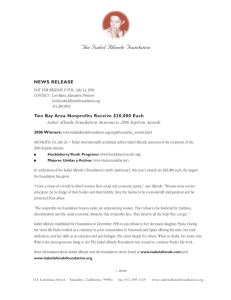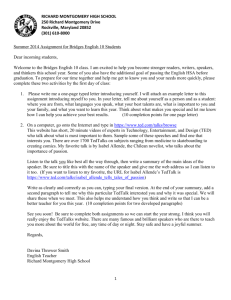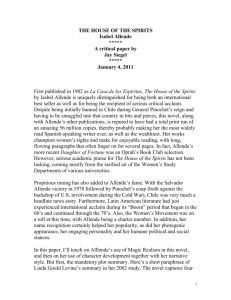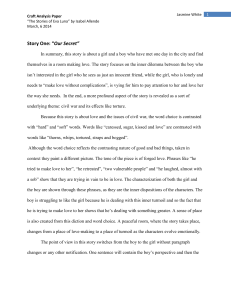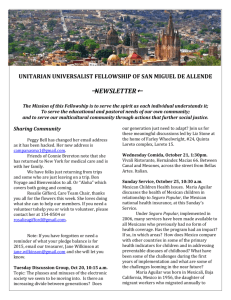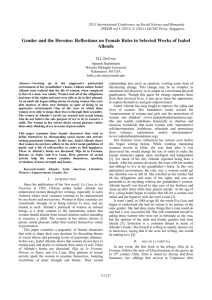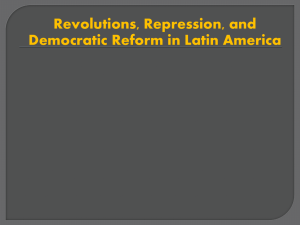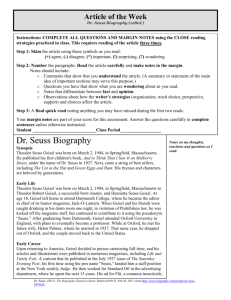Bias in Fiction - Bensalem Township School District
advertisement
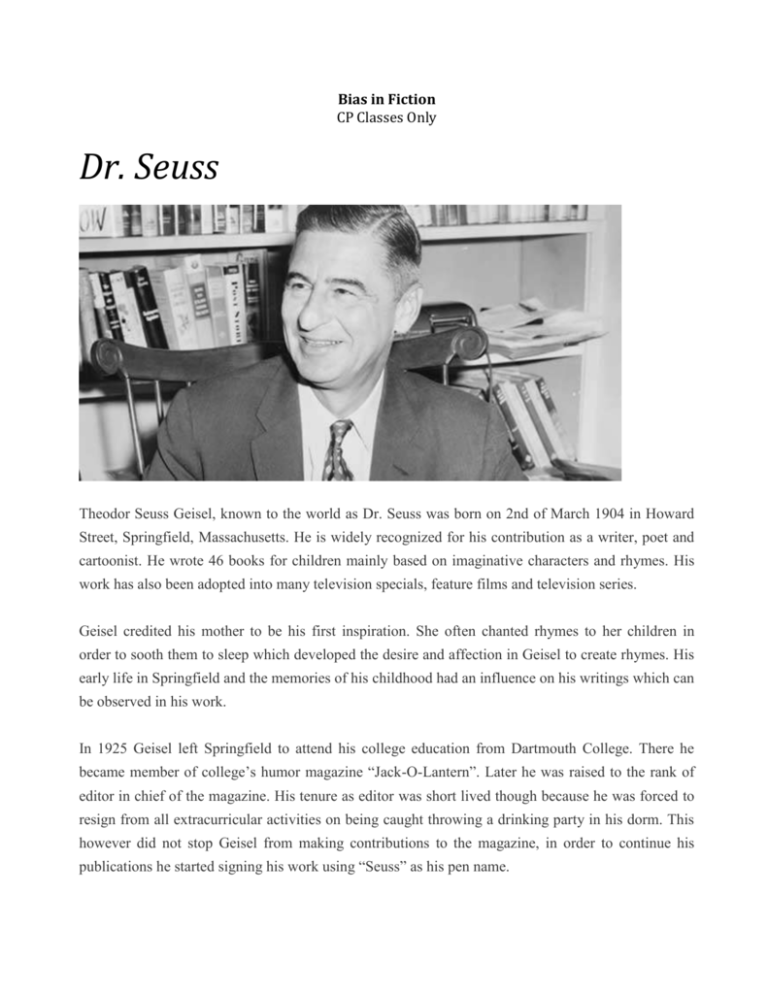
Bias in Fiction CP Classes Only Dr. Seuss Theodor Seuss Geisel, known to the world as Dr. Seuss was born on 2nd of March 1904 in Howard Street, Springfield, Massachusetts. He is widely recognized for his contribution as a writer, poet and cartoonist. He wrote 46 books for children mainly based on imaginative characters and rhymes. His work has also been adopted into many television specials, feature films and television series. Geisel credited his mother to be his first inspiration. She often chanted rhymes to her children in order to sooth them to sleep which developed the desire and affection in Geisel to create rhymes. His early life in Springfield and the memories of his childhood had an influence on his writings which can be observed in his work. In 1925 Geisel left Springfield to attend his college education from Dartmouth College. There he became member of college’s humor magazine “Jack-O-Lantern”. Later he was raised to the rank of editor in chief of the magazine. His tenure as editor was short lived though because he was forced to resign from all extracurricular activities on being caught throwing a drinking party in his dorm. This however did not stop Geisel from making contributions to the magazine, in order to continue his publications he started signing his work using “Seuss” as his pen name. Upon his passing out from Dartmouth College, Geisel went on to Oxford for fulfilling his father’s dream, who wanted him to become a college professor. He entered Lincoln College to earn a Doctorate degree in English Literature, a task he never accomplished. After his return to United States, Geisel became associated with different magazines which include The Judge, Liberty and Vanity Fair. He started submitting humorous articles to these magazines. His advertisement for a common insecticide company called Flit, won him national recognition. Seuss made his first publication as cartoonist on 16th July 1927 in The Saturday Evening Post. During the World War II era, Geisel turned his focus towards political cartoons. He drew more than 400 cartoons for New York’s daily newspaper, PM. With the aim to extend his contributions to the war efforts, Geisel got enrolled in US army as commander of the Animation Department. There he made a series of adult army training films. His work with First Motion Picture Unit of US Army introduced him to the art of animation. As the war ended, Geisel moved to California and resumed his work on children’s books. He wrote many famous books which won him wide recognition and appreciation. In 1954 Geisel was approached by William Ellsworth Spaulding, the director of the education division at Houghton Mifflin, to write a book using only 250 out of preselected 348 words which William thought were important for first grade students to learn. The idea was inspired by the report published in Life magazine on illiteracy among school children. The report said that children were unable to learn reading because their books were boring. The result was “The Cat in the Hat”; a perfect blend of Geisel’s verse rhythms, drawing skills and imaginative power. This book along with others written for your young children, were huge success both at national and international level. On 24th September, 1991, Dr. Seuss died of throat cancer in San Diego, California. His honors included two Academy awards, two Emmy awards, a Peabody award and the Pulitzer Prize. Bias in Fiction H and GT Classes Only Isabel Allende Isabel Allende Biography Born: August 2, 1942 Lima, Peru Chilean novelist, journalist, and dramatist The author of several novels and a collection of short fiction, as well as plays and stories for children, Chilean author Isabel Allende has received international praise for her writing. Many of her books are noted for their feminine point of view and dramatic qualities of romance and struggle. Her first novel, The House of the Spirits, was made into a film in 1994. Early years in Chile Isabel Allende was born on August 2, 1942, in Lima, Peru. Her parents, Tomás (a Chilean government representative) and Francisca (Llona Barros) Allende divorced when she was three. After the divorce Isabel traveled with her mother to Santiago, Chile, where she was raised in her grandparents' home. Her grandmother's interest in fortune telling and astrology (the study of the influence of the stars on human behavior), as well as the stories she told, made a lasting impression on Allende. The house was filled with books, and she was allowed to read whatever she wanted. Allende graduated from a private high school at the age of sixteen. Three years later, in 1962, she married her first husband, Miguel Frías, an engineer. Allende also went to work for the United Nations Food and Agricultural Organization in Santiago, where she was a secretary for several years. Later she became a journalist, editor, and advice columnist for Paula magazine. In addition she worked as a television interviewer and newscaster. Exile in Venezuela When her uncle, Chilean president Salvador Allende (1908–1973), was assassinated in 1973 as part of a military takeover of the government, Isabel Allende's life changed greatly. At first she did not think that the new government would last, but later she came to realize that it was too dangerous to stay in Chile. As a result she, her husband, and their two children fled to Venezuela. Although she had established a successful career as a journalist in Chile, she had a difficult time finding similar work in Venezuela. During her life in exile Allende was inspired to write her debut novel, The House of the Spirits (1982), which became a best seller in Spain and West Germany. Based on Allende's memories of her family and the political change in her native country, the book describes the personal and political conflicts in the lives of several generations of a family in a Latin American country. These events are communicated through the memories of the novel's three main characters: Esteban and Clara, the father and mother of the Trueba family, and Alba, their granddaughter who falls into the hands of torturers during a military takeover. The House of the Spirits earned the Quality Paperback Book Club New Voice Award nomination. The novel was adapted by the Danish writer and director Bille August and was released as a film in the United States in 1994. The House of Spirits was followed by Of Love and Shadows, which concerns the switching at birth of two infant girls. One of the babies grows up to become the focus of a journalist's investigation, and the revelation of the woman's assassination compels the reporter and her photographer to go into exile. The novel received a Los Angeles Times Book Prize nomination. While on a lecture tour in San Jose, California, to promote the publication of Of Love and Shadows in the United States, Allende met William Gordon, a lawyer, who was an admirer of her work and with whom she fell in love. Having been divorced from her first husband for about a year, she married Gordon in 1988 and has lived with him in Marin, California, ever since. Became powerful storyteller As she became more popular, Allende decided to devote all of her time to writing and quit her job as a school administrator. Her next book, Eva Luna (1988), focused on the relationship between Eva, an illegitimate (born to unmarried parents) writer and storyteller, and Rolfe Carlé, an Austrian filmmaker haunted by the knowledge of his father's criminal past. The novel received positive reviews and was voted One of the Year's Best Books by Library Journal. Allende followed up this novel with The Stories of Eva Luna (1991), in which Eva relates several stories to her lover Carlé. The Eva Luna stories were followed by The Infinite Plan (1993) that, unlike her other books, features a male hero in a North American setting. Gregory Reeves is the son of a traveling preacher who settles in the Hispanic section of Los Angeles after becoming ill. Local gang members torment Reeves, as he is the only Caucasian (white) boy in the district. Eventually he finds his way out of the neighborhood, serves in the army, and goes on to study law. The Infinite Plan received less praise than Allende's previous books. Still, as novelist Jane Smiley pointed out in her Boston Globe review, "Not many [authors from foreign countries] have even attempted writing a novel from the point of view of a native of the new country." Allende's next work, Paula (1995), was a heartbreaking account of the circumstances surrounding the long illness and death of her daughter in 1991. Published in 1999 Daughter of Fortune is the story of Eliza Sommers, a girl who breaks with nineteenth-century Chilean tradition to follow her lover to California. In September 1996 Allende was honored at the Hispanic Heritage Awards for her contributions to the Hispanic American community. In 1998 she received the Dorothy and Lillian Gish Prize for excellence in the arts. Another novel, Portrait in Sepia, was published in 2001. Read more: http://www.notablebiographies.com/A-An/Allende-Isabel.html#ixzz3LDp9sFZ0
